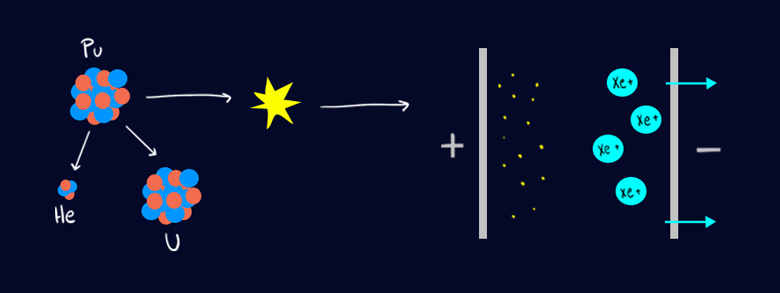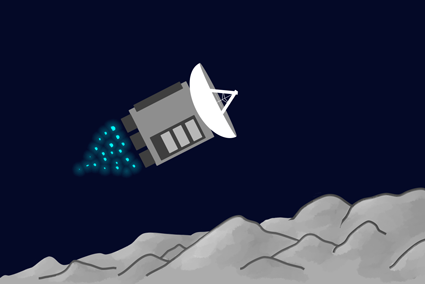Astronomers Prepare a Mission Concept to Explore the Ice Giant Planets
NASA scientists imagined some innovative technologies that could enhance a future mission to Uranus or Neptune
:focal(240x163:241x164)/https://tf-cmsv2-smithsonianmag-media.s3.amazonaws.com/filer/5a/06/5a066e76-d4ea-4b97-a845-7a4e57aa2754/illustration-spacecraft-uranus-800x600.png)
If you could design your dream mission to Uranus or Neptune, what would it look like?
Would you explore the funky terrain on Uranus’s moon Miranda? Or Neptune’s oddly clumpy rings? What about each planet’s strange interactions with the solar wind?
Why pick just one, when you could do it all?
Planetary scientists recently designed a hypothetical mission to one of the ice giant planets in our solar system. They explored what that dream spacecraft to Uranus could look like if it incorporated the newest innovations and cutting-edge technologies.
“We wanted to think of technologies that we really thought, ‘Well, they’re pushing the envelope,’” said Mark Hofstadter, a senior scientist at the Jet Propulsion Laboratory (JPL) and California Institute of Technology in Pasadena. “It’s not crazy to think they’d be available to fly 10 years from now.” Hofstadter is an author of the internal JPL study, which he discussed at AGU’s Fall Meeting 2019 on 11 December.
Some of the innovations are natural iterations of existing technology, Hofstadter said, like using smaller and lighter hardware and computer chips. Using the most up-to-date systems can shave off weight and save room on board the spacecraft. “A rocket can launch a certain amount of mass,” he said, “so every kilogram less of spacecraft structure that you need, that’s an extra kilogram you could put to science instruments.”
Nuclear-Powered Ion Engine
The dream spacecraft combines two space-proven technologies into one brand-new engine, called radioisotope electric propulsion (REP).
A spacecraft works much like any other vehicle. A battery provides the energy to run the onboard systems and start the engine. The power moves fuel through the engine, where it undergoes a chemical change and provides thrust to move the vehicle forward.

In the dream spacecraft, the battery gets its energy from the radioactive decay of plutonium, which is the preferred energy source for traveling the outer solar system where sunlight is scarce. Voyager 1, Voyager 2, Cassini, and New Horizons all used a radioisotope power source but used hydrazine fuel in a chemical engine that quickly flung them to the far reaches of the solar system.
The dream spacecraft’s ion engine uses xenon gas as fuel: The xenon is ionized, a nuclear-powered electric field accelerates the xenon ions, and the xenon exits the craft as exhaust. The Deep Space 1 and Dawn missions used this type of engine but were powered by large solar panels that work best in the inner solar system where those missions operated.
Xenon gas is very stable. A craft can carry a large amount in a compressed canister, which lengthens the fuel lifetime of the mission. REP “lets us explore all areas of an ice giant system: the rings, the satellites, and even the magnetosphere all around it,” Hofstadter said. “We can go wherever we want. We can spend as much time as we want there….It gives us this beautiful flexibility.”
A Self-Driving Spacecraft
With REP, the dream spacecraft could fly past rings, moons, and the planet itself about 10 times slower than a craft with a traditional chemical combustion engine. Moving at a slow speed, the craft could take stable, long-exposure, high-resolution images. But to really make the most of the ion engine, the craft needs onboard automatous navigation.
“We don’t know precisely where the moon or a satellite of Uranus is, or the spacecraft [relative to the moon],” Hofstadter said. Most of Uranus’s satellites have been seen only from afar, and details about their size and exact orbits remain unclear. “And so because of that uncertainty, you always want to keep a healthy distance between your spacecraft and the thing you’re looking at just so you don’t crash into it.”
“But if you trust the spacecraft to use its own camera to see where the satellite is and adjust its orbit so that it can get close but still miss the satellite,” he said, “you can get much closer than you can when you’re preparing flybys from Earth” at the mercy of a more than 5-hour communications delay.

That level of onboard autonomous navigation hasn’t been attempted before on a spacecraft. NASA’s Curiosity rover has some limited ability to plot a path between destinations, and the Origins, Spectral Interpretation, Resource Identification, Security, Regolith Explorer (OSIRIS-REx) will be able to detect hazards and abort its sample retrieval attempt.
The dream spacecraft would be more like a self-driving car. It would know that it needs to do a flyby of Ophelia, for example. It would then plot its own low-altitude path over the surface that visits points of interest like chaos terrain. It would also navigate around unexpected hazards like jagged cliffs. If the craft misses something interesting, well, there’s always enough fuel for another pass.
A Trio of Landers
With extra room on board from sleeker electronics, plus low-and-slow flybys from the REP and autonomous navigation, the dream spacecraft could carry landers to Uranus’s moons and easily drop them onto the surface.

“We designed a mission to carry three small landers that we could drop on any of the satellites,” Hofstadter said. The size, shape, and capabilities of the landers could be anything from simple cameras to a full suite of instruments to measure gravity, composition, or even seismicity.
The dream spacecraft could survey all 27 of Uranus’s satellites, from its largest, Titania, to its smallest, Cupid, only 18 kilometers across. The mission team could then decide the best way to deploy the landers.
“We don’t have to decide in advance which satellites we put them on,” he said. “We can wait until we get there. We might decide to put all the landers on one satellite to make a little seismic network to look for moonquakes and study the interior. Or maybe when we get there we’ll decide we’d rather put a lander on three different satellites.”
“Ice”-ing on a Cake
The scientists who compiled the internal study acknowledged that it’s probably unrealistic to incorporate all of these innovative technologies into one mission. Doing so would involve a lot of risk and a lot of cost, Hofstadter said. Moreover, existing space-tested technology that has flown on Cassini, New Horizons, and Juno can certainly deliver exciting ice giant science, he said. These innovations could augment such a spacecraft.
At the moment, there is no NASA mission under consideration to explore either Uranus or Neptune. In 2017, Hofstadter and his team spoke with urgency about the need for a mission to one of the ice giant planets and now hope that these technologies of the future might inspire a mission proposal.
“It’s almost like icing on the cake,” he said. “We were saying, If you adopted new technologies, what new things could you hope to do that would enhance the scientific return of this mission?”
This article was originally published on Eos, an Earth and space science news publication.